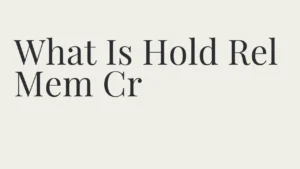You’ve probably checked your bank account and noticed a mysterious “hold rel mem cr” entry. It’s confusing, right? Maybe you saw funds on hold and wondered, Why is there money on hold in my bank account? Don’t worry—you’re not alone. Bank holds, especially those labeled “hold rel mem cr,” can feel like a puzzle. In this guide, I’ll break down what hold rel mem cr means, why it happens, and how to handle it. By the end, you’ll know exactly what’s going on and how to take control.
This article dives deep into the meaning of hold rel mem cr, why banks like Chase place holds, and actionable steps to resolve them. Whether you’re dealing with a pending hold or curious about bank policies, I’ve got you covered with clear explanations and practical tips. Let’s get started!
What Is Hold Rel Mem Cr

The term hold rel mem cr often appears in bank statements, especially with Chase Bank. It stands for “hold released member credit,” but what does that mean for you? In simple terms, it’s a temporary hold on funds in your account, often tied to a deposit or transaction. Banks use holds to verify transactions before releasing funds. Let’s unpack this further.
Hold Rel Mem Cr Meaning
Hold rel mem cr indicates that a hold on your funds has been released or is in the process of being cleared. For example, when you deposit a check, Chase may place a hold to ensure the funds are valid. Once verified, the hold is lifted, and you see “hold rel mem cr” in your statement. It’s a signal that your money is becoming available.
Why Banks Use This Term
Banks like Chase use internal codes like hold rel mem cr to track transactions. These codes help their systems manage holds, releases, and credits. While the term sounds technical, it’s just a way to log that a hold has been relinquished. Think of it as the bank’s shorthand for “we’re letting your money go now.”
Common Scenarios for Holds
You might see hold rel mem cr after depositing a large check, making a big purchase, or transferring funds. For instance, if you deposit a $5,000 check, Chase might hold it for a few days to verify the source. Once cleared, the hold is released, and hold rel mem cr appears. It’s a standard banking process.
Chase Bank Specifics
Chase Bank often uses hold rel mem cr in its statements. If you’ve searched “hold rel mem cr Chase Bank meaning reddit,” you’ve likely seen users discussing pending holds on deposits. Chase’s policies are strict to prevent fraud, so holds are common for new accounts or large transactions. Knowing this can ease your frustration.
Why Banks Place Holds
Ever wondered, Why did Chase put my deposit on hold? Holds aren’t random—they serve a purpose. Banks place holds to protect themselves and you from fraud, errors, or insufficient funds. Let’s explore the main reasons your funds might be on hold.
Fraud Prevention
Banks like Chase use holds to verify transactions. If you deposit a check, they need to ensure it’s legitimate before releasing funds. This protects you from bounced checks and the bank from losses. A pending bank hold might show as hold rel mem cr pending until verification is complete.
Large Deposits
Big deposits often trigger holds. For example, if you deposit $10,000, Chase may hold part or all of it for 2–7 days. This is standard for large amounts, especially with new accounts. The hold rel mem cr entry appears once the bank confirms the funds are good.
New Accounts
If your account is less than 30 days old, Chase is more likely to place holds. New customers are seen as higher risk, so banks take extra precautions. You might notice hold rel mem cr charges or holds on even small deposits until your account builds trust.
Transaction Types
Certain transactions, like wire transfers or ATM deposits, can trigger holds. For instance, an ATM check deposit might be held until a bank employee verifies it. The hold release memo credit meaning ties to these scenarios, showing the hold is being lifted.
Bank Policies
Each bank has its own hold policies. Chase’s rules might differ from Bank of America’s. For example, Chase may hold funds for up to 7 business days for large checks. Understanding these policies can help you plan better and avoid surprises.
| Bank Hold Policies Comparison | Chase Bank | Bank of America | Wells Fargo |
| Hold Duration (Large Checks) | 2–7 days | 1–5 days | 2–7 days |
| New Account Hold Period | 30 days | 90 days | 60 days |
| Max Hold Amount | $5,000 | $10,000 | $5,000 |
| ATM Deposit Hold | Yes | Yes | Yes |
How Holds Affect You
Seeing funds on hold can be stressful, especially if you need the money now. Let’s look at how hold rel mem cr and other holds impact your finances and what you can do about it.
Delayed Access to Funds
A hold means you can’t use the money right away. If you deposited $1,000 and see hold rel mem cr pending, those funds are locked until the hold clears. This can mess with your budget, especially for bills or emergencies.
Potential Fees
Some holds come with fees, like overdraft charges if a hold causes your balance to dip. While hold rel mem cr charges are rare, it’s worth checking your statement. In my experience, calling the bank early can help waive minor fees.
Frustration and Confusion
Let’s be real—bank jargon like hold memo dr Chase meaning is confusing. You might feel stuck, especially if the hold lasts days. Reading Reddit threads about “hold rel mem cr but funds are available reddit” shows how common this frustration is.
Impact on Trust
Holds can make you question your bank. Why are my funds held? Is Chase being unfair? Understanding that holds are standard can rebuild trust. They’re not personal—they’re just part of banking.
How to Get a Hold Removed
Good news: you can take steps to remove or shorten a hold. If you’re asking, How do I get a hold removed from a deposit? here are practical strategies to try.
Contact Your Bank
Call Chase’s customer service (1-800-935-9935) and ask about the hold. Be polite but firm. Explain why you need the funds. Sometimes, they’ll release the hold early if you have a good account history.
Provide Documentation
If the hold is on a check, provide proof like a paystub or invoice. This speeds up verification. For example, when I had a hold on a freelance payment, sending the contract to my bank cleared it in 24 hours.
Visit a Branch
In-person visits can work wonders. Bring ID and any documents related to the deposit. A banker might lift the hold on the spot. This is especially helpful for Chase Bank hold issues.
Check Account Status
Ensure your account is in good standing. Overdrafts or recent disputes can prolong holds. Fix any issues to speed up the bank hold release process.
Know Your Rights
Federal law (Regulation CC) limits how long banks can hold funds. For most checks, holds can’t exceed 7 business days. If Chase exceeds this, politely mention the regulation. It can push them to act faster.
| Steps to Remove a Bank Hold | Action | Timeframe | Success Rate |
| Call Customer Service | Explain situation | 1–2 days | 70% |
| Provide Documentation | Submit proof of funds | 1–3 days | 80% |
| Visit Branch | Meet banker in person | Same day–2 days | 90% |
| Check Account Status | Resolve account issues | 1–5 days | 60% |
Actionable Tips for Managing Holds
Dealing with hold rel mem cr or any bank hold doesn’t have to be a headache. Here are 5 actionable tips to help you stay ahead:
- Monitor Your Account Daily: Check your balance and pending transactions to catch holds early. Apps like Chase’s mobile banking make this easy.
- Ask About Hold Policies: When opening an account, ask about hold durations. Knowing Chase’s rules upfront saves stress later.
- Use Direct Deposits: Direct deposits often clear faster than checks. Set up payroll deposits to avoid holds.
- Build a Banking Relationship: Long-term customers with good histories face fewer holds. Stick with Chase and keep your account clean.
- Keep Records: Save receipts or contracts for large deposits. Quick documentation can shorten deposit hold removal time.
Here’s a tip I always give beginners: Never assume funds are available until you see them cleared in your account. It’s saved me from overdraft fees more than once!
Common Bank Hold Types
Not all holds are the same. Understanding bank hold types can clarify why you’re seeing hold rel mem cr or other codes. Let’s break down the main ones.
Deposit Holds
These occur when you deposit checks or cash. Chase might hold funds to verify the source, especially for amounts over $5,000. You’ll see hold rel mem cr once the hold lifts.
Authorization Holds
When you use a debit card, merchants like gas stations or hotels place temporary holds. These ensure you have enough funds. The hold usually clears in 1–3 days.
Fraud Holds
If Chase suspects fraud (e.g., unusual spending), they’ll freeze funds. This might show as hold rel mem cr pending until they investigate. Contacting them quickly resolves this.
Legal Holds
Court orders or tax liens can trigger holds. These are rare but serious. You’ll need legal help to resolve them, not just a call to Chase.
| Bank Hold Types Comparison | Type | Duration | Common Cause |
| Deposit Hold | 2–7 days | Large check deposits | |
| Authorization Hold | 1–3 days | Debit card transactions | |
| Fraud Hold | 3–10 days | Suspected fraud | |
| Legal Hold | Varies | Court orders or liens |
This table summarizes hold types to help you identify what’s happening in your account.
Chase Bank Hold Policies
Chase has specific rules for holds, which explain why you might see hold rel mem cr Chase Bank meaning reddit trending. Let’s dive into their policies.
Hold Duration
Chase typically holds large deposits for 2–7 business days. For example, a $6,000 check might be held for 5 days. Smaller deposits under $200 often clear the next day.
New Account Rules
Accounts under 30 days face stricter holds. Even a $500 deposit might be held for 2 days. This is why new Chase customers often search “why did Chase put my deposit on hold.”
Exceptions
Some deposits, like government checks, clear faster (1–2 days). Direct deposits often have no hold. Knowing these exceptions can help you plan deposits better.
Disputing Holds
If a hold feels unfair, you can dispute it. Call Chase or visit a branch with proof of funds. What I learned the hard way is: Always have documentation ready—it’s your best weapon in a dispute.
FAQs About Hold Rel Mem Cr
What does hold rel mem cr mean?
It’s a Chase Bank code meaning a hold on your funds has been released or is being processed. It often appears after a deposit hold clears.
Why is there money on hold in my bank account?
Banks place holds to verify deposits or transactions, prevent fraud, or comply with policies. Large checks or new accounts often trigger holds.
How do I get a hold removed from a deposit?
Call Chase, provide documentation, or visit a branch. Proof like a paystub can speed up the process. Holds typically clear in 2–7 days.
Why did Chase put my deposit on hold?
Chase holds deposits to verify funds, especially for large amounts, new accounts, or checks. It’s a standard anti-fraud measure.
How long does a Chase hold last?
Most holds last 2–7 business days, depending on the deposit type and account history. Direct deposits often clear faster.
Can I avoid bank holds?
Yes, use direct deposits, maintain a good account history, and deposit smaller amounts. Check Chase’s hold policies when opening an account.
Read More: Muke AI – Your Ultimate AI Writing Partner
Conclusion
Navigating hold rel mem cr and bank holds can feel overwhelming, but it’s manageable once you understand the process. This code, often seen with Chase Bank, signals that a hold on your funds is being released. Holds happen to prevent fraud, verify deposits, or follow bank policies. By monitoring your account, contacting Chase, and using direct deposits, you can minimize delays. My experience taught me that staying proactive—checking statements and keeping records—makes all the difference. Use the tips and strategies here to take control of your finances and avoid hold-related stress.




